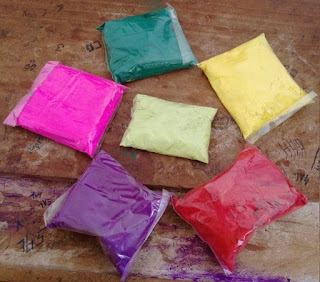 |
| Holi_colours |
Holi
is a celebration of the onset of spring. Farmers celebrated happy
harvest every year at this time and welcomed the season of spring
with celebrations. Since then, the tradition of celebrating with
dance, music and colours started.
Once
upon a time, the colours used during Holi were prepared from the
flowers of trees that blossomed during spring like flowers of ‘tesu’
or ‘palash’ tree and known as gulal. Most of these trees also had
medicinal properties and the colours obtained from them were highly
beneficial to the skin and body. With the rapid commercialisation of
this festival and a strong demand for other colours, artificial
colours,consisting of a large number of chemicals, became
easily available. These poses serious health issues.
The
best way to prevent any powder from sticking to your skin is to
moisturise well beforehand. Some people also oil their hair so that
the powder is easier to remove, or wear a hat. It is also recommended
that anyone taking part uses home-made powders with ingredients that
are guaranteed to be non-harmful or use oraganic colors . One way you
can do this is by putting together a mix of flour, water and a few
splashes turmeric(yellow), red rose petals(red), jaccarda
flowers(blue), mehendi(green).
Holi,
known as the ‘festival of colors’ is celebrated on the full moon
day falling in the month of Phalguna (Feb-Mar). It takes place over
two days, and is a celebration of fertility, colour, and love, as
well as the triumph of good versus evil. The word "Holi"
originates from "Holika", the evil sister of demon king
Hiranyakashipu.
As
per ancient mythology, blinded by special powers King Hiranyakashipu,
grew arrogant, thought he was God, and demanded that everyone worship
only him. However, his own son, Prahalad refused to worship his
father and remained a true devotee of Lord Vishnu. Out of frustration
and anger, Hiranya Kasyap tries to kill his son Bhakta Prahlada by
using his sister Holika, who is fire resistant, then due to the
blessing of Maha Vishnu Prahlada came out from the fire safely but
Holika burnt in that fire. Lord Vishnu arrived in the earth as
Narasimha avatar and killed Hiranyakashyap portraying the victory of
good or evil.
Another
legend goes with Lord Shiva. Shiva is known for his meditative nature
and his many hours spent in solitude and deep meditation. Madana, the
God of love, decided to test his resolve and appeared to Shiva in the
form of a beautiful nymph. But Shiva recognized Madana and became
very angry. In a fit of rage he shot fire out of his third eye and
reduced her to ashes. This is sometimes given as the basis of Holi's
bonfire.
It
also draws on the legend of enduring love between Lord Krishna (an
incarnation of Vishnu) and Radha. It is said that as a child, Sri
Krishna was envious of Radha’s fair complexion, and on the advice
of his mother, he went and playfully painted her face so it was the
same colour as his. It is said that lovers often celebrate Holi in
this tradition, by colouring their faces the same colour during the
celebrations.
The
timing of Holi is synchronised with the moon, which means that the
dates of each celebration varies year on year. Holi is split into two
events: Holika Dahan and Rangwali Holi. This year Rangwali
Holi will take place on 2 March 2018 while
the pyres of Holika Dahan will be burned the evening beforehand.
Holika
Dahan takes place the night before Rangwali Holi. Wood and dung-cakes
are burned in a symbolic pyre to signify good defeating evil
(According to hindu Mythology, the God Vishnu helps burn the devil
Holika to death). This year, Holika Dahan will be celebrated on March
1. Timings for the Holika Dahan will be from 6 pm to 8: 30 pm after
the Bhadra period is gone.
The
next morning, people gather in public spaces and take part in
Rangwali Holi. This is a raucous affair where people chase each other
around, throwing handfuls of coloured powders (known as gulal) at one
another, while getting drenched in water. Social gatherings such as
parties with food are organized at several places. Parties, and
spending time with friends, family and other loved ones are also
crucial aspects of Holi. Moreover, giving out sweets and delicacies
is another important part of the festival’s celebrations. That’s
why this festival is also known as the Festival of Spreading Joy.
Holi is a relatively secular one. People take part in Holi all around
the world, but it is celebrated the most in parts of India and Nepal.
 |
| Google_Doodle_Holi_2018 |
This
year Google is celebrating Holi with a new festive doodle that seeks
to bring out the colourfulness associated with the festival.
Characters in blue, red, yellow and green celebrating Holi replace
the traditional Google logo that has its letters painted with those
very colours. The Google Doodle depicts dhol players, those who love
spraying colour through pichkaaris and those who colour others with
traditional gulaal as well. The festival, which marks the end of
winter and the coming of spring, symbolically shows the triumph of
good over evil.
The
four main colors of Holi in the Google Doodle represent many
different things that are in line with the festival. Red stands for
love, yellow is the colour of turmeric, which is a powder used as an
anti-septic, blue represents the Hindu god Krishna and green
symbolises new beginnings with the coming of spring. The Google
Doodle has been designed by Amrita Marino.
The
festival of Holi is celebrated all across the country with a lot of
enthusiasm and gaiety. Holi also fosters unity among people as the
festival also includes the tradition of forgiving enemies and letting
go past grudges. Let the essence of colours of holi compel us to hope
for a dreamy world full of rainbows....
Happy
and Safe Holi...
